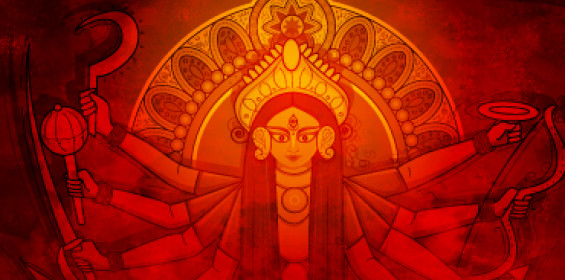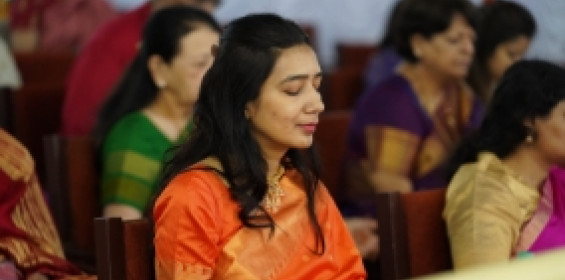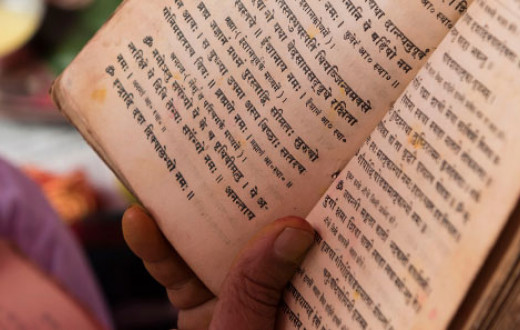I decided to write about Akhand Jyot (or Jyoti), as I assumed that performing its rituals makes me well-versed in its knowledge. Little did I know till I decided to reconfirm with puja experts. The insights rendered by Swami Harihara, Aruna Sareen and Rajni Dhawan, Faculty, The Art of Living have been an eye-opener to me and here I share them with you all.
From Ghatasthapana to Kanya pujan and Jai Ambe Gauri Aarti to Durga Saptashati Paath, Akhand Jyot is the most important element of the Navratri puja vidhi.
What is the meaning and significance of Akhand Jyot?
‘Akhand’ means uninterrupted or unextinguished and ‘Jyot’ means flame. It is an oil or ghee lamp that lights continuously for 9–10 days during Navratri in reverence of the Mother Divine (Durga). The flame signifies that we imbibe the qualities (compassion, unconditional love, contentment, and generosity) of the Mother Divine or Shakti.
Jyot represents pure knowledge, intellect, and creative talent.

The process of seeing in the physical world happens with physical light being reflected on the eyes and then through the retina and optic nerve, the brain cognizes an object. The wonder however is when we imagine objects in our minds or in dreams. We do see things without any physical light and interestingly the brain’s visual cortex is stimulated even during dreams or imagination. This means that an unknown aspect of light is lighting up our mind space (Chittakash). Many have reported experiencing light in their meditation.
With reference to the Gayatri mantra, Akhand Jyot represents the light that is eternally enlightening the three worlds, “…bhur bhuvah suvah…” - Bhootakash (the outer space), Chittakash (the space where emotions and thoughts originate) and Chidakash (the space of consciousness). Thus, Jyot is the representation of the Mother Divine, Gayatri.

The significance of Akhand Jyot will be incomplete without insight into the Vedas. Durga Suktam describes Goddess Durga as that divine eternal fire in which we can offer and be free from the effects of the three karmas, namely,
Agami (effects of our present and past actions yet to manifest),
Sanchita (total accumulated effects of past actions )
Prarabdha karma (manifestation of effects of past actions in the present)
Akhand Jyot is a traditional ritual during Navratri that is followed at home, temples, ashrams, and offices, where devotees take a sankalpa to keep the holy flame lit for a specific period. There are temples where Akhand Jyot has been continuously lit for many years.
The mention of “manav tu apna mool pehchan tu jyoti swaroop he” in ancient scriptures signifies that we originate from the eternal light. Over a period of time, due to stress, we tend to forget the essence of our being. So lighting Akhand Jyot in festivals like Navratri reinforces this knowledge in us as we reconnect with ourselves.
How to light Akhand Jyoti in Navratri
For Akhand Jyoti, use a long and thick Baati (cotton wick) or make it of Mauli.
Use brass, silver, or earthen lamp.
Fill the holy lamp with pure sesame, or mustard oil, or ghee (preferably made from desi cow’s milk).
Akhand Jyoti sthapana or establishment should be done on a clean chowki.

Draw an Ashtadal (a pattern of an eight-petalled lotus) with gulal or raw rice on the chowki. It signifies purity, enlightenment, self-reconnect, prosperity, and harmony with the self and the cosmos.
At an auspicious time (refer to the Vikram samvat) place the Akhand lamp in the center of the Ashtadal. Place ghee diya on the right side of the Goddess while oil diya should be kept on the left side.
Perform pooja of the Akhand lamp. Apply kumkum (roli) bindi or dot on the lamp symbolizing enthusiasm and offer rice (akshat), the symbol of prosperity.
Light the diya reciting the Sanskrit shloka

शुभं करोति कल्याणमारोग्यं धनसंपदा ।
शत्रुबुद्धिविनाशाय दीपज्योतिर्नमोऽस्तुते ॥1॥
“Salutations to the light of the lamp, the originator of auspiciousness, health and prosperity, that destroys hostile feelings.”
“Salutation to the light of that lamp.”
Keep removing the overburnt portion of the inflamed end of the wick with a stick, at regular intervals.
There is a traditional practice of sowing barley (Jware or Jowar) with the Akhand Jyot as an offering of the first crop of the spring season. It also teaches us to respect our grains. It signifies prosperity.
Mantra chanting is accompanied by the Jyot lighting.
Do's of Akhand Jyot
✔️It requires utmost purity, care and reverence for the Mother Divine.
✔️Keep a sufficient length of wick to help it remain ignited until the end of the ninth day of the festival.
✔️Keep a watch on the holy flame to ensure it is always.
✔️Fill the Akhand lamp with ghee (or oil) at regular intervals. Ensure the inflamed end of the wick doesn't get immersed in the fuel.
✔️Always keep the Akhand lamp covered with a glass or metallic cover.
✔️If you choose an earthen lamp, keep it soaked in water overnight to prevent it from absorbing excess oil or ghee while burning the holy flame.
✔️To ensure the holy lamp keeps burning while you are adjusting its wick, light another lamp and then adjust the holy wick. Either put off the spare lamp by immersing its wick or let it burn itself out.
✔️Let the holy flame extinguish itself after Navratri.
✔️Fast during the nine days of Navratri to keep the body and mind satvic which aids in connecting with the self.
Sankalpa or intention is a desire that has arisen from a peaceful and strong mind. Navratri pujas and homas are a perfect opportunity to take Sankalpa.
Dont's of Akhand Jyot
❌Don’t let kids play around the Akhand Jyot to prevent it from blowing off.
❌Don’t pour solid ghee into the lamp; instead melt it. Solid ghee may put off the holy flame if not melted properly.
❌Don’t light the lamp near the toilet, bathroom or inauspicious place.
❌Don’t leave the Akhand Jyoti burning at a place unattended. This is regarded as “showing our backs to the holy lamp” or being disrespectful to the Mother Divine.
❌Don’t let the holy flame blow off due to the breeze while adjusting the flame or any other reason.
❌Don’t use sunflower oil in the lamp.
❌Don’t displace the Akhand Jyot from its place for the 9 days of Navratri.
❌Don’t eat non-vegetarian food, onion and garlic. These are tamasic in nature. Navratri is all about uplifting the satva in the body, mind and self.
❌Couples abstain from sleeping together to preserve the satva guna during Navratri.
Based on inputs by Swami Harihara, Aruna Sareen and Rajni Dhawan, Faculty, The Art of Living.
Inspired by Gurudev Sri Sri Ravi Shankar’s wisdom talks
Written by: Pratibha Sharma
We’d love to hear from you!
Please write to us @artofliving about what you feel about the Akhand Jyot of Navratri.
Related links
Top 10 Devi Bhajans by The Art of Living
FAQs on Navratri Akhand Jyot
You must ensure that Akhand Jyot doesn’t go off. Keep a spare lamp lit while you are adjusting the Akhand wick and ghee/oil. Still, if it goes off, light it with a prayer to the almighty and connect with the eternal light within your consciousness.
In Navratri, devotees of the Mother Divine light the Akhand Jyoti (eternal lamp) and offer it to Mother Goddess Durga. The Jyoti symbolizes knowledge, purity, good luck, positive energy and prosperity. In other words, it denotes the absence of darkness/ignorance and the removal of doubts. It brings clarity to our thoughts. It also removes diseases from the vicinity of the Jyot.
1. The long flame on the baati or wick of Akhand Jyot indicates that the baati is pulled out more on the Diya. It will consume the oil or ghee faster, and you will have to refill the Diya more often. So pull out the baati little by little so that the flame is small.
2. Ensure the inflamed end of the wick doesn't get immersed in the fuel while you adjust its length.
3. More flowing air on the wick makes it burn faster. Keep the Akhand Jyot protected with a glass or metallic cover.
4. For Akhand Jyoti, use a long and thick Baati (cotton wick) or make it of Mauli.
5. Keep removing the overburnt portion of the inflamed end of the wick with a stick at regular intervals.
Place the Akhand Diya or Deepam in the center of the Ashtadal to the right of the Mother Divine on the chowki or the altar. Some devotees put a fist of wheat under the Akhand Diya instead of the Ashtadal.
Melt the ghee before you pour it into the Akhand Diya as the solid ghee doesn't fuel the wick instantly.



































